Athens Through the Lens of Global Cinema
When Herodou Attikou, a crossroads in...
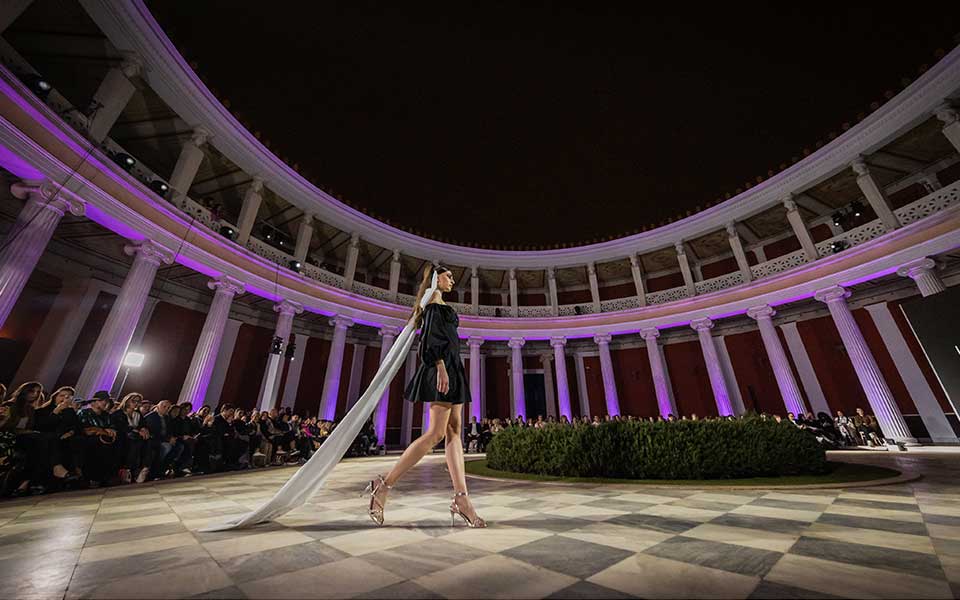
Koulouris
© Studio Panoulis
The 34th Athens Fashion Week (April 20-24) had us falling in love with the capital all over again.
A creative crowd gathered at the Zappeion and a few other well-chosen venues throughout the city for five evenings of shows full of energy and art. We saw the latest collections from over 20 Greek designers – some internationally-known, some emerging artists – along with the work of some current students.
Fashion week isn’t an industry-only event. Like a music festival, it’s a community celebration. Tickets for individual shows are available to anyone, and many were fans of the houses. It was a great crowd to be around. Athenians look good – part Mediterranean sprezzatura, part world-city urban cool. Another nice thing about the way Athenians dress is a sense of identity; they very often dress local. There are many Greek designers working in the capital, responding to the city’s street style and lifestyle with a range of distinctive looks. Another plus is that most pieces are made in Greece, some right here in the city.
Highlights included:
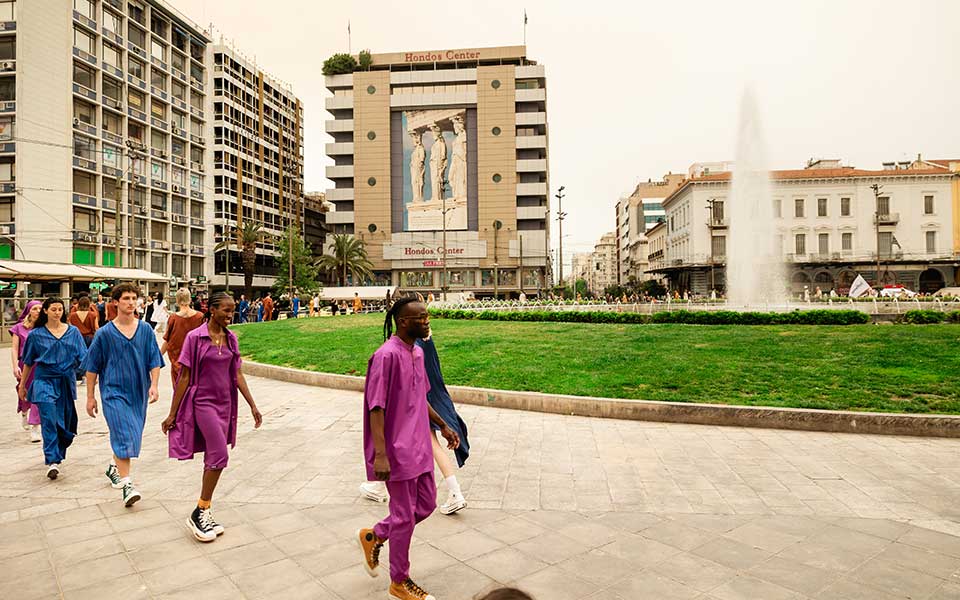
© Studio Panoulis
Parthenis has been on the city’s sartorial landscape since 1970, when Dimitris Parthenis opened his first store in Athens (Mykonos followed in 1978). Their very likable philosophy –quality natural fabrics; long, lean silhouettes; fluidity of motion; and a fresh, natural palette –remains unchanged. Orsalia Parthenis, Dimitris’ daughter, is staying true to the same bohemian elegance. With a flattering unisex aesthetic that loosely branches into lines for women and men, the brand has a broad and lasting reach. You could see this at the show; many fans were wearing pieces from seasons past.
But what made this show one of the most talked-about events was the venue: surrounded by traffic in Omonia Square. We’ve got lots of squares in Athens, and pretty much all of them are more picturesque; Omonia was a meaningful choice, embracing the grittiness of the city that both the house and its fans love and call home. The faded neoclassical façades of what were once two grand hotels designed by the 19th-century architect Ernst Ziller, the multi-story Hondos Center with its huge banner of the Karyatids, and the recently restored mega-sculpture “Five Circles” by Zongolopoulos made the perfect backdrop. To everyone’s delight, a large percussion band got a solid, relaxed beat going and kept it up as the models, representing a wide range of ages, ethnicities, body types, and orientations/identities, showed off the Spring/Summer ’24 collection “Earthbound”. On their feet were Converse sneakers – perfect with the different looks and moreover good for keeping up a brisk, urban pace as they made the round of the whole plaza. For the finale, two long lines of models crossed paths – more than one breaking into spontaneous dance – to meet up under the Zongolopoulos sculpture. The violet and saffron pieces – this season’s signature colors amid the flattering neutrals – lent the scene a warm glow. Under skies rapidly turning an apocalyptic orange (it was during that sandstorm of the 23th of April), the whole mood was one of inclusive, urban confidence.
All pieces are completed by small workshops in Athens.
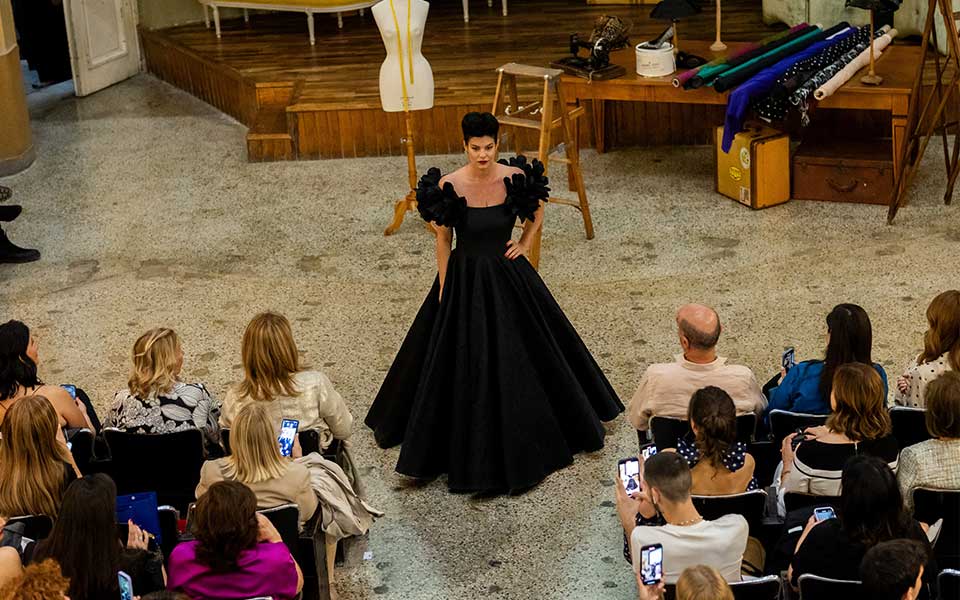
Vassilis Zoulias
© Studio Panoulis
Just as distinctly Athenian, Vassilis Zoulias’ aesthetic takes us to another Athens altogether. The shop window of his boutique – Vassilis Zoulias Old Athens – on Academias offers a glimpse of an Athens past, with a retro glamour we all know from black-and-white Finos Films. Zoulias’ works are resolutely feminine, channeling an era that emphasized a voluptuous form, a defined waist and, above all, a feminine grace: “My memories of my mother have really defined me. I remember her in the ’60s, getting together with her impeccably dressed girlfriends for a game of Gin Rummy in the afternoons. I was positively haunted by twinsets, black pencil skirts and pearl necklaces. Their style was burned into my memory.” It’s a fortunate thing that it was; these classic looks have never looked more relevant than they do in his hands. The experience of buying his works is an event: all pieces are created to order, imparting a deeper sense of engagement with the piece and connection with the local artisans employed by the atelier.
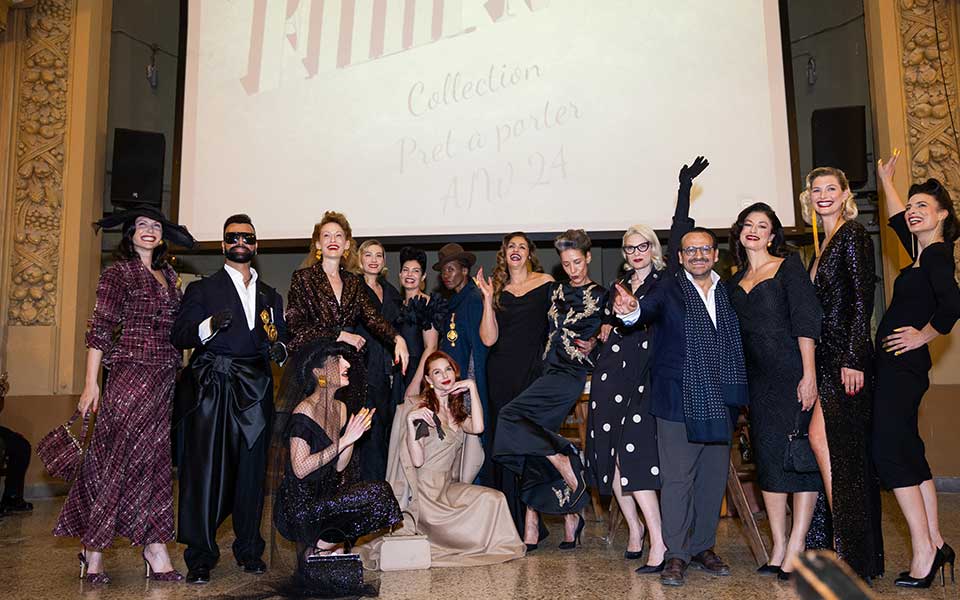
Vassilis Zoulias
© Studio Panoulis
The Iris is a historic now disused cinema from the heyday of nearby Omonia Square. Zoulias used the venue “as is (still beautiful, it’s also in disrepair – some chairs were blocked off for safety, adding a further note of authenticity). The show’s Film Noir theme – it began with clips from Casablanca and other films – was a perfect fit for the FW ’24-’25 collection. A dressmaker’s atelier was set up below the screen. The house lights were even and high – no spots, no colored lighting – ideal for appreciating the restrained palette of camel, some bordeaux, and black that looked better than ever. Jewelry by Pericles Kondylatos was the perfect complement to the outfits. The silhouettes, from pencil dresses to belted coats full of swing, were magnificent. The last two looks brought the audience to their feet in spontaneous applause; they were modeled by the internationally famous model Marpessa Hennick and by the actress and model Vicky Koulianou.
(The international crowd will know Zoulias through several looks that have featured in the TV show “Emily in Paris”.)
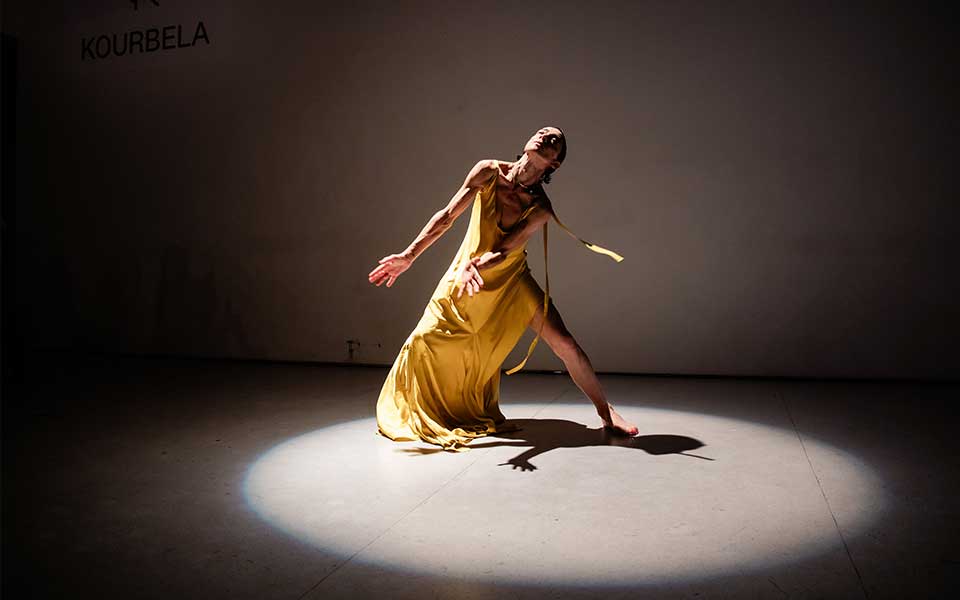
Ioanna Kourbela
© Studio Panoulis
Ioanna Kourbela shared her Spring/Summer ’25 collection in solid colors at Metaphor Athens – not with a show, but with a dance performance, choreographed by Andi Xhuma. An installation of her white collection featured bridal dresses from different periods in a range of subtle shades and rich contrasting textures of natural materials. The Dassios collection was a celebration of Greek style, graceful and lean, with sometimes asymmetrical, beautifully textural pieces that suggested an ancient antecedent while remaining current and engaging.
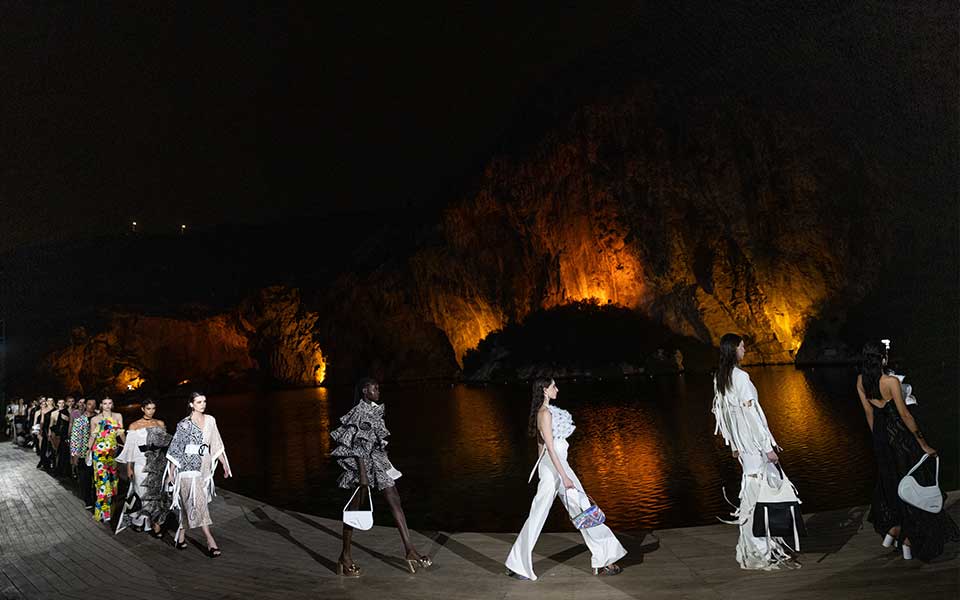
Paris Valtadoros
© Studio Panoulis
Lake Vouliagmeni by night, the cliffs lit from below, made an ideal setting for the Paris Valtadoros collection “Mystique.” There were shimmering fabrics and body-contouring dresses with a graceful fluidity of motion, sleeves of fantastic flounce, and dresses of elaborate construction with an almost sculptural presence. Daphne Valente’s body-affirming collection “Lost My Marbles” featured her magnificent signature pleating, and the neoclassical Zappeion was a nice setting for the looks. These were among several more excellent shows.
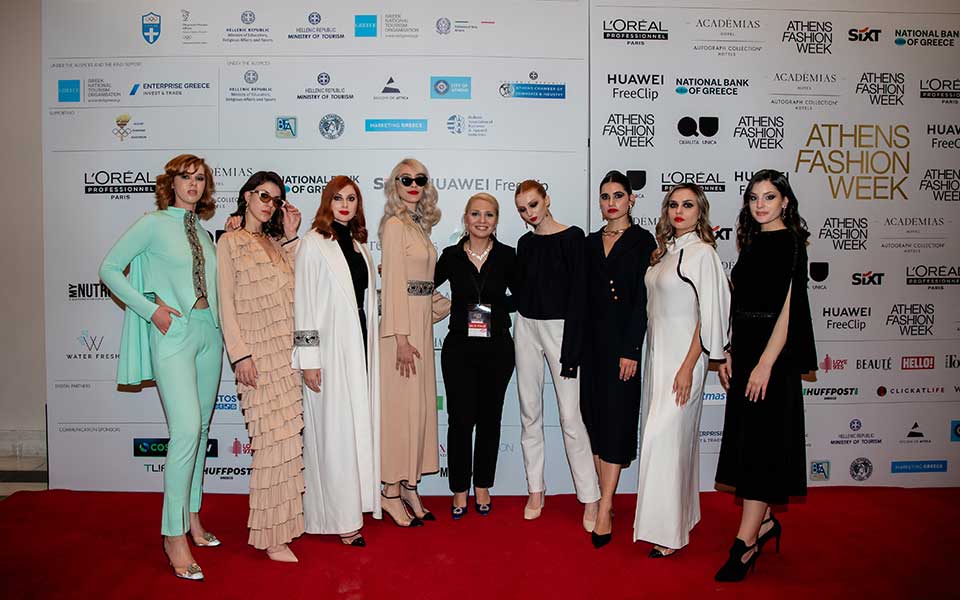
Anchor
© Studio Panoulis
The Wednesday evening shows of new designers at the Zappeion were a particular highlight. This was a very feel-good night – a little loud, with a young, enthusiastic crowd. There was a wide spectrum of engaging looks over the four-plus hours, and a couple of innovative standouts. Of these, Atelier L’amour et L’âme (Lamprini Mourouti) seemed to channel a little Bouguereau, perhaps the Pre-Rafaelites for dreamy and diaphanous Georgian line looks, and breathtaking simplicity. The mood was pastoral – like what Marie Antoinette might have worn at her Petit Hameau – and the elaborate floral headwear really worked. Mourouti received this year’s Best Catwalk award for the dreamy spectacle.
Later on, Blue (Pavlos Kyrkos) took us somewhere completely different, almost beyond imagination. Futuristic and fantastical, this collection looked like clothing for some parallel world. Perhaps, however, he’s introducing an effective way to dress for our own; a quote from Camus on his site suggests as much: “The only way to deal with an unfree world is to become so absolutely free that your very existence is an act of rebellion.” These are rebellious clothes. Emotionally daring, his collections are autobiographical, reflections of his inner emotional states. Certainly that’s true on a philosophical level; on the aesthetic level, they’re empowering, and moreover often really fun. A purple suit of sculptural construction – amazing shoulders and sleeves – set off a round of audible excitement. A purple cape was a wonder of complex geometry, a fantasy piece of origami suitable for wearing in an enchanted forest. Blue won the best new designer award, and – judging from the reaction – the crowd was very happy about it. So was I, and then even more so when I looked him up and saw that he been born in 2000 in Ioannina, and raised there as well, and that he’d studied both Italian Literature and Fashion Design.
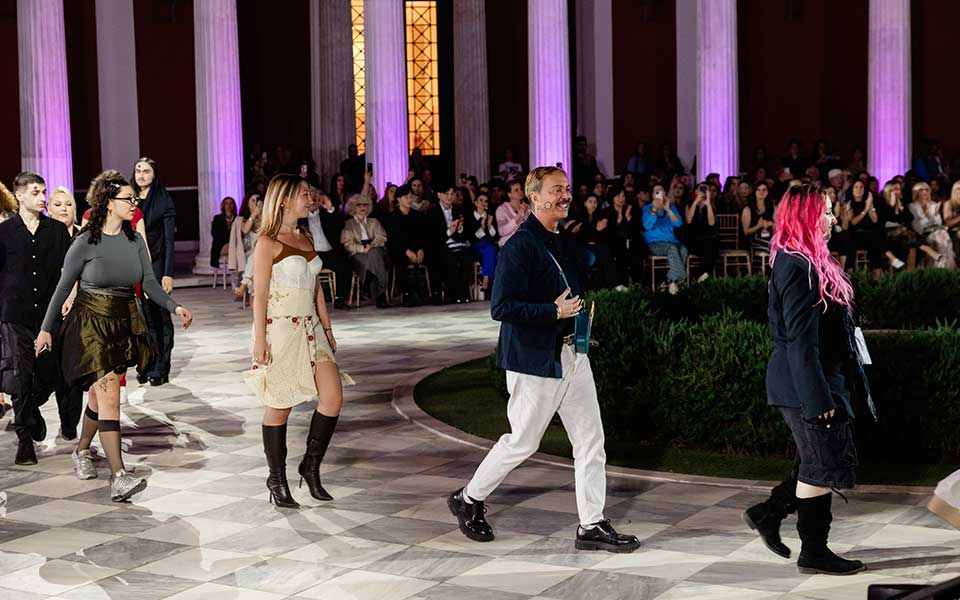
Lakis Gavalas
© Studio Panoulis
Other new collections included P. Anchor, which defines itself as a “Lifestyle Sustainable brand inspired by the kingdom of the sea.” The looks backed it up, winning the designer the Best Trendsetter award. Christina Manelidi’s work was modern in color – grey, purple and pink – and sculptural, with a sometimes folkloric feel in the cape element and in a smock-like dress, both of substantial cloth. Another piece, with its draped element creating a two-toned geometric pattern, put me in mind of a modern Sarakatsani (nomadic herders of northern Greece) garment. Ioannis Koulouris showed a colorful collection of looks combining street style with an occasional stand-out detail (an enormous bow around the neck of one model reached the floor and drew some attention from the crowd). Sifis Stathaikis’ collection was all about straight-up glamour – mainly evening looks – in an often playful palette.
The show “Gavalas and the New Generation IEK ALFA” featured Lakis Gavalas and works of emerging designers, including Eva Crannel, Papadopoulou Maria, Hers, Evlyn Angel, Irene Dalla, Maria Kariofili, Dex, Chaing, Doykisa Haska, Charis Symeonof, La Femme Bleu, and Infiny.
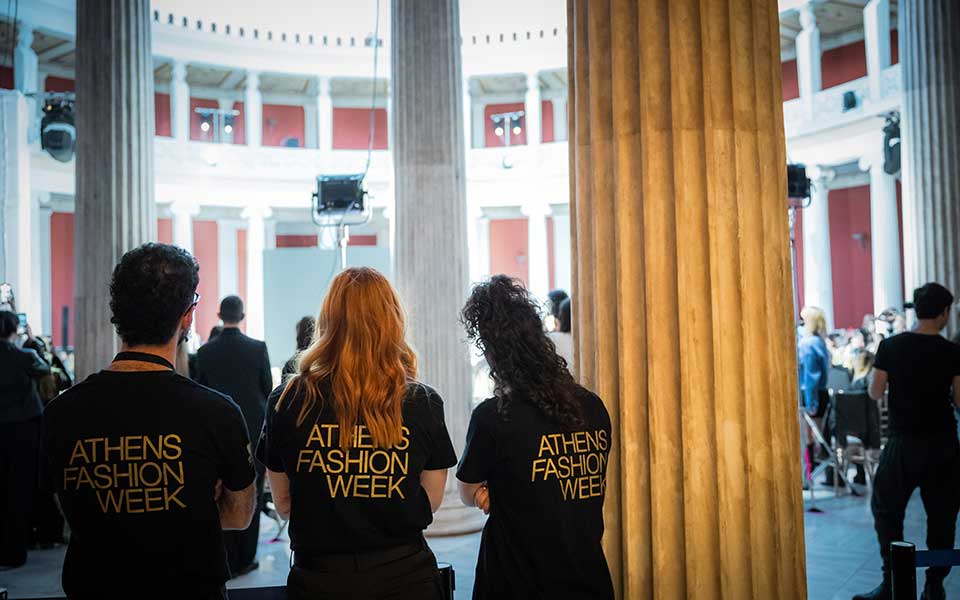
© Studio Panoulis
An installation at the Zappeion connected to the Olympic Games featured some of the magnificent original costumes by Sophia Kokosalaki for the Athens 2004 opening ceremony, as well as one of the Mary Katranzou pieces – the wearable Ionic column – for the priestesses at this year’s flame ceremony. It was the ideal presentation of what makes Greek fashions distinctive. It seems that being raised so near the marvelous marble Karyatids has given Greek designers an intuitive sense of drapery and pleating, as well as a sense of the body and proportions. We certainly see it, in a modern sense, in the works of Ioanna Kourbela – whose pieces can have an elemental, almost Cycladic presence – and in the beautiful pleating of Daphne Valente.
That sense of the body and the flowing line is also beautifully expressed by Angelos Bratis. You see it in the natural lines in Parthenis, too, in the simple geometries of traditional folk clothing. Of things folkloric, however, no one captures the rich heritage of Greek embroidery quite like Dimitris Dassios. His background is in the theater – he had a career at the Greek National Opera and also as a designer of costume jewelry and eventually stage costumes –which gives him an overview of Greece’s sartorial history.
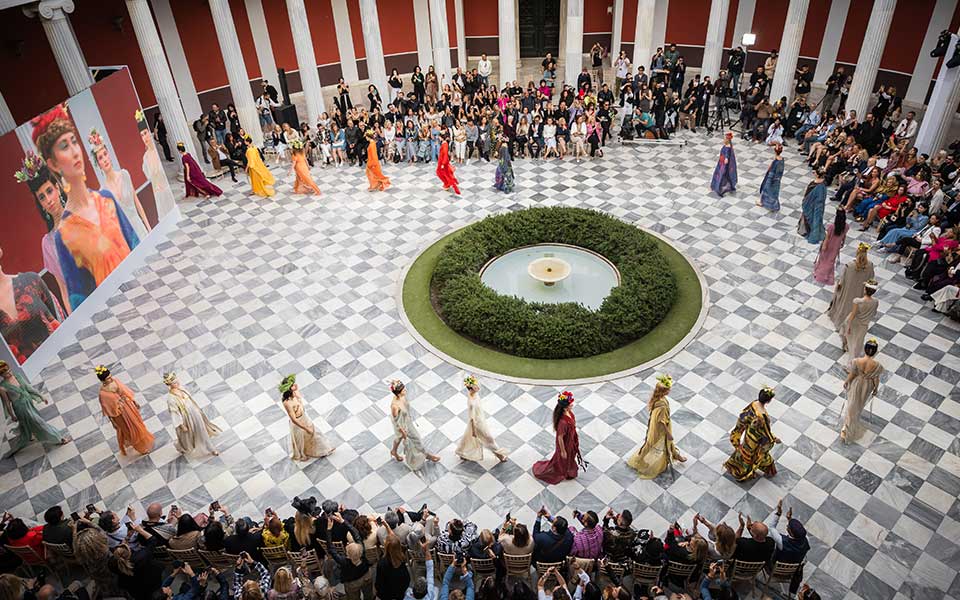
Dassios
© Studio Panoulis
The heritage of ancient Greek drama (to say nothing of philosophy) can also prove liberating for designers engaging with very bold looks. We see it in some of Valtadoros’ more sculptural works, and we see it in the work of Blue, whose pieces seem to create their own universe.
The designers’ choice of materials and palettes also often expresses a Greek identity. Greece has a long history of excellence in the textile industry, and many designers use sustainable local fabrics. Greek cotton in particular is a standout for quality. The serenity of the natural Greek palette – clean Cycladic blues and whites, the many cool and warm whites of pebbles on the beach, the rich royal red of porphyry reminiscent of roof tiles – is a frequent inspiration, making the clothes fit in effortlessly with their natural surroundings.
Above all, whether it’s in Zoulias’ classic looks of Old Athens, or in Kourbela’s natural pieces for a modern urban goddess, or the pieces of any of the designers we’re so fortunate to have working here in the city, the sense of Greek identity always goes hand in hand with a sense of contemporary relevance.
When Herodou Attikou, a crossroads in...
This summer, Pelagos at Four Seasons...
Abra Ovata is itself a rare...
Whether you’ve just stepped off a...